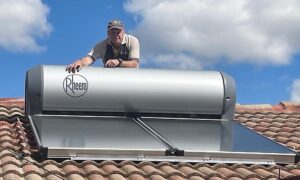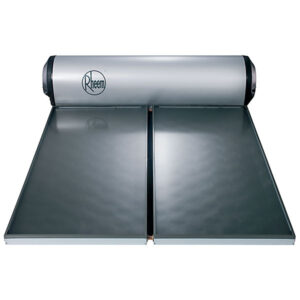Rheem Hiline 52H300 SS is the
best solar hot water system for Canberra’s climate
Based on more than 30 years’ experience in the Canberra region and your frequently asked questions we are confident that the roof-mounted Rheem Hiline 52H300 SS solar hot water system meets all of the requirements to be rated the number 1 hot water system you should install in the Canberra region.
The Rheem Premier Hiline solar water heater is ideal for cooler climates in both suburban and rural settings, in areas prone to frost and with low mineral content. With the tank on the roof above the collectors, it’s a great option when ground access is limited, and power supplies are not secure.
We rated the installation of this hot water system based on its value for money, longevity, serviceability, spare parts, after sales service, efficiency, and long-term environmental impacts. The ACT Government’s zero emissions policy also contributed to our decision.


Price vs longevity – 3 out of 5

Despite generous rebates, the price is still at the high end of the scale. The 300 litre Hiline with a stainless steel tank is three times the price of a gas or electric storage hot water system and can be double the price of some base model heat pump hot water systems. However, it is 10% cheaper to purchase than an evacuated tube system. These systems will typically last as long as a gas or electric storage hot water system, twice the life of an evacuated tube system, and may last three to four times longer than many heat pump hot water heaters installed in Canberra at present.
Efficiency – 4 out of 5

Typically, these systems on average will be around 300% efficient. However, when combined with a timer to limit electric boosting to the late afternoon, average efficiencies can reach 400% and higher. The electric booster is 95% efficient at converting electrical energy into heat energy. If the system is sized correctly and installed in a manner that optimises solar efficiency, then electric boosting will be less frequent.
Reliability – 5 out of 5

This is probably the most reliable hot water system available in Australia and is very reliable in Canberra’s cold climates. This is due to anti-freeze/anti boil glycol fluid that circulates at low pressure by thermosyphon between the collectors and the storage tank. Because of the thermosyphon principal there are no pumps, sensors, electronic controllers, or flow and return pipes that can fail. The electric booster is a simple resistant element controlled by an inbuilt thermostat. The boost function can be controlled by an overridable time clock. The glass in the panels is robust enough to take on most medium sized hail stones and will not shatter as easily as evacuated tubes. They are less affected by the cold than heat pumps too.
Serviceability, spare parts and after sales service – 3 out of 5

Being manufactured by Rheem, spare parts for this system are very easy to get. However, there are few spare parts required and servicing is easy as there are literally no moving parts between the solar hot water panels and the hot water storage tank. It is still recommended that you find experienced service people to undertake servicing and repairs. Being roof-mounted, the costs of servicing can be double that of other storage hot water systems.
Impact to the environment – 5 out of 5

The Rheem Premier Hiline 52H300 SS has less embedded energy than modern hot water heat pumps and does not require the mining and processing of rare earths like modern heat pumps and PV solar systems do. The long life expectancy and fewer breakdowns also contribute to its environmental credentials. With the right orientation and when installed with a timer for the electric booster, this system can operate with an average efficiency of 400% in the Canberra region. This is slightly lower than evacuated tube hot water systems with a time clock but is higher than any heat pump hot water system on the market.
Value for money – 5 out of 5

This model has been known to continue to produce solar hot water well beyond 20 years. This is twice the likely life of an evacuated tube hot water system and may be as much as three to four times longer than the expected life of some heat pump hot water systems. Minor servicing is required once every 5 years and a major service is required once every 12 years. When installed with a timer on the booster, operating costs can be further reduced. Because the Hiline system does not require sensors or pumps and does not require electronic frost protection, breakdowns are less frequent, and therefore less boosting is required over its lifetime. While the initial cost is high, the savings over the life of the Rheem Premier Hiline make it real value for money.
Running costs excluding repairs and maintenance – 5 out of 5 (average 3 stars)

Highest score in front of electric storage, gas storage, gas continuous flow and heat pump hot water systems.
Compatibility with ACT Government’s zero emissions policy – 5 out of 5

When installed correctly and to optimise efficiency, this Rheem roof mounted solar hot water heater is more than compatible with the ACT Government’s climate change policies. It reduces the reliance on energy stored in a BESS and can store hot water at moderate temperatures for days without boosting. Additionally, most of the energy stored inside the storage tank comes directly from the sun. It does not place any significant additional load on the ACT electricity network and owners of this system are not adversely affected by the increasing price of electricity.
Total score – 35 out of 40

Downsides
It is on the high side for price. Because the tank is mounted on the roof, it is heavier than split system solar hot water systems and roof structures may need to be strengthened. And unless you have a north, northwest or west-facing roof with no shading, gaining maximum efficiency can be difficult.
Finding experienced service technicians that know what they are doing can also be tricky. This system can sometimes boil in summer if there is little hot water demand, which is more of a nuisance than anything else. These system take up a lot of space and hot water recovery can be slow.
This makes them unsuitable for most commercial applications and apartment buildings. They are also effected by shade from neighbouring trees and buildings, though morning shade in Canberra is not a major concern.
FAQ Answered
What is the cheapest way to get hot water?
In the past I would have answered, “gas hot water is the cheapest way to get hot water in Canberra.” However, the ACT Government’s electrification policy is forcing the price of natural gas up. I could easily argue that heat pumps and most solar hot water systems are not the cheapest way to get hot water. This is because even though they use less power, their purchase price is high, some break down more frequently than gas and electric storage hot water systems and some heat pumps have a much shorter life in Canberra of around five to seven years. Presently the cheapest way to get hot water in Canberra is via a large capacity standard electric storage hot water system, connected to a solar PV system with the power supply controlled by a time clock. This is if you can afford the solar PV system and do not have a BESS.
Is gas hot water better than solar?
Gas hot water heaters are typically more reliable than solar hot water heaters and the purchase price of a gas hot water system is a third of the price of a solar hot water system. However, ACT Government policy is forcing up the price of gas, and the gas in our networks comes from fossil fuels. Therefore, solar hot water from a Rheem Premier Hiline roof mounted system will soon be better than hot water from a gas hot water heater in Canberra.
Cheap green gas, like renewable hydrogen, will one day take the place of natural gas in our gas networks. When that day comes gas again will be a better way to get hot water than solar in Canberra.
What is the most energy efficient hot water heater?
The most efficient hot water system in the canberra region is an electric-boosted evacuated tube solar hot water system with a time clock on the booster. However, we don’t recommend that you rush out and buy one. These systems are prone to hail damage, frosts, bird damage, heat damage and bad installation practices. They rely heavily on sensors and electronics, that only increase the number of things that can go wrong.
What is the life span of a solar hot water system?
The life span of a heat pump ranges from four years to maybe ten years. We haven’t seen many older than ten years, but there is a new wave of installations and heat pump models that may prove us wrong. Standard solar hot water systems with flat panel collectors or evacuated tubes have a life span ranging from ten years to thirty years. The oldest solar hot water system that we have ever replaced in Canberra was 39 years old.
Is Solahart owned by Rheem?
Yes, Solahart is owned by Rheem and the range of Solahart hot water systems are equal to those with a Rheem badge. We did not include Solahart installations in our best 5 list because of the time it takes to get parts and their exclusivity agreements with suppliers.
Is solar hot water cheaper than gas?
The purchase price of a solar hot water system is typically three times more than the purchase price of a gas hot water system. When installed properly and to optimise efficiency, some solar hot water systems will be cheaper to operate than a gas hot water system over their lifetime. The maintenance costs of a solar hot water system are significantly higher than the maintenance costs of a gas hot water system.
Is solar hot water gas or electric?
Solar hot water systems can be boosted both either gas and electricity.
If we have been able to help you make a choice, we can also provide you with a competitive quote for all hot water installations and replacements.
Thank you for reading our Why the Rheem Premier Hiline 52H300 SS made the top 5 hot water system review for Canberra, compared to heat pumps, electric & gas storage and gas instant water heaters page
